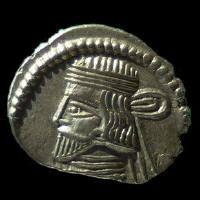Later Parthian Drachms with "Rounded Beards"
Identifying Look-alike Parthian Drachms
There are two main groups of "rounded beard" drachms which can be immediately separated based on diadem pendant count of the obverse portrait. The drachms of Vardanes II are identified by five pendants from the diadem, while Vardanes I and Vologases III have only three pendants. The number of pendants can be clearly discerned on these example photos:
| Five pendants |
Three pendants |
 |
 |
Group I: Five pendants
Group II: Three pendants
Group I: The Drachms of
Vardanes II (c. A.D. 55 - 58)
The drachms of Vardanes II (type 69) always have five pendants attached to the diadem of the obverse portrait. The beard is semicircular or quadrant shaped.
Group II: Differentiating the Drachms of
Vardanes I (c. A.D. 40 - 47) and Vologases III
(c. A.D. 105 - 147)
These drachms always have three pendants attached to the diadem of the obverse portrait. All Vardanes I (type 64) and one subtype of Vologases III (type 78.1) drachms have a short and somewhat rounded or quadrant-shaped beard. To differentiate them:
- Check the inscription on the reverse to clarify which king minted the coin:
- In line two (ΒΑΣΙΛΕΩΝ) of the inscription:
- Omega is rounded on drachms of Vardanes I (type 64)
- Omega is angular like a Lambda on Vologases III (type 78)
- Some other letters such as Epsilon are equally distinctive between the two types. In line two (ΒΑΣΙΛΕΩΝ) of the inscription:
- Epsilon is fully formed on drachms of Vardanes I (type 64)
- Epsilon has only the vertical and one horizontal element on Vologases III (type 78), appearing as

- Vardanes I silver drachms (type 64.31) have the monogram AT, and the portrait's forehead always has three short lines, one horizontal and two diagonal, but these are often unseen on worn coins.
- The remaining Vardanes I drachms (types 64.32-37) are of debased silver, lack details, and have barbarized Greek legends; however, they are distinctively different in portrait and will not be confused with drachms of Vologases III

